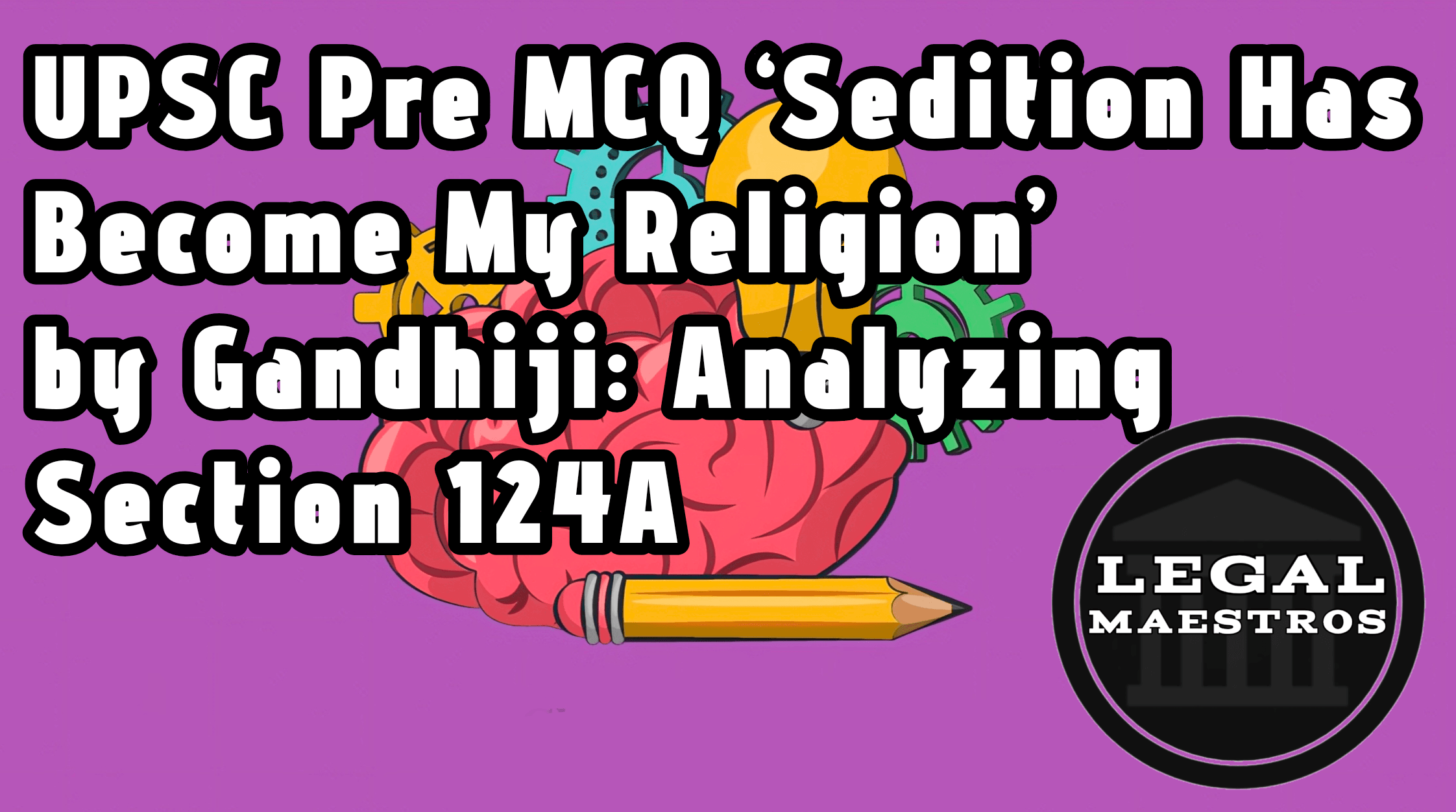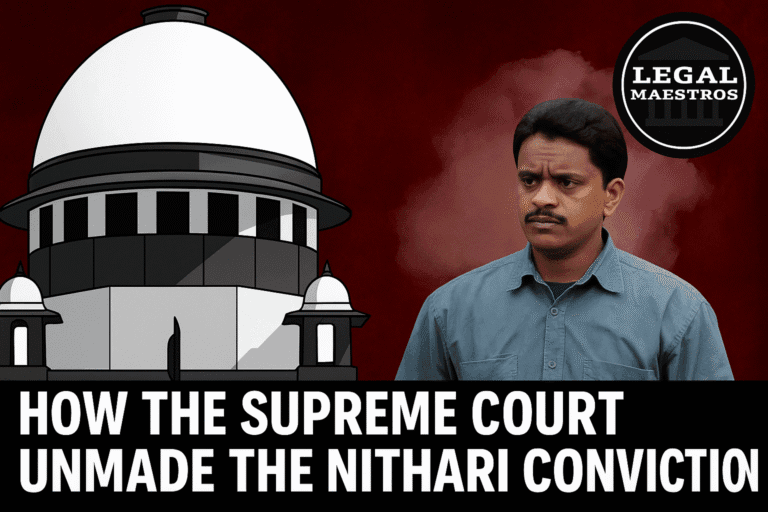
Under British control in India, the act of seditious speech was made a criminal offense in the year 1870. This act was subsequently codified as Section 124A of the Indian Penal Code in the year 1872.
In order to suppress political opposition, this law made it unlawful to “bring into hatred or contempt” or to arouse disaffection against the government. Its purpose was to stifle political dissent. This repressive law was flipped on its head by Mahatma Gandhi, who advocated for nonviolent resistance.
He did this by publicly embracing sedition rather than avoiding it. It is important to note that his famous statement, “Sedition has become my religion,” was not a boastful statement; rather, it was a conscious challenge to the legitimacy of colonial power and an assertion of moral obligation.
For any queries or to publish an article or post or advertisement on our platform, do call at +91 6377460764 or email us at contact@legalmaestros.com.
It is important to get an understanding of the history, applicability, and contemporary interpretations of Section 124A because it illustrates how a colonial weapon against dissent has survived into the legal arsenal of independent India and continues to spark discussion about the exercise of free speech.
Contextualization of Section 124A in History by
Sedition laws were enacted by the British government in an effort to suppress the burgeoning Indian independence movement. As a result of the new clause, the government began to investigate and prosecute political leaders like Bal Gangadhar Tilak with regard to their early political publications and speeches.
Because of the law’s ambiguous language, it was open to a wide range of interpretations; appeals for reform, criticism of government officials, or criticism of government policy might all be considered seditious.
For any queries or to publish an article or post or advertisement on our platform, do call at +91 6377460764 or email us at contact@legalmaestros.com.
Over the course of several decades, a large number of editors, activists, and intellectuals have been arrested and imprisoned, frequently for the sole purpose of expressing their opinions at public meetings or newspapers.
Sedition became as a term for political repression, which had the effect of suppressing even peaceful forms of protest. It was by the late 1920s that the harshness and arbitrary application of the law had become a rallying point for freedom fighters who condemned its use against nonviolent protest.
For More Updates & Regular Notes Join Our Whats App Group (https://chat.whatsapp.com/DkucckgAEJbCtXwXr2yIt0) and Telegram Group ( https://t.me/legalmaestroeducators )
For any queries or to publish an article or post or advertisement on our platform, do call at +91 6377460764 or email us at contact@legalmaestros.com.
The Declaration Adopted by Gandhi at Dandi
On April 6, 1930, Gandhi took salt from the mud that was found along the coast at Dandi, so symbolically challenging the British monopoly on the manufacture and taxation of salt! He addressed an ever-increasing throng and declared that the law that elevated political expression to the level of a criminal offense was wrong. He also stated that he considered sedition to be a badge of honor.
It was through his statement that he reframed an instrument of repression as an act of conscience. He said, “Sedition has become my religion.” In contrast, he claimed that disobedience was a moral necessity, and that obeying laws that were wrong would only serve to perpetuate tyranny. Sedition was transformed into a symbol of nonviolent resistance rather than criminality as a result of this dramatic reframing, which rallied supporters across India and attracted attention from individuals all over the world.
Evolution and Provisions are discussed in Section 124A.
When it was first enacted, Section 124A prohibited words, whether they were said or written, that incited discontent with the existing government. Over the course of time, a number of adjustments were made to clarify that disaffection encompassed both feelings of disloyalty and feelings of animosity; yet, the fundamental nature of disaffection remained constant.
For any queries or to publish an article or post or advertisement on our platform, do call at +91 6377460764 or email us at contact@legalmaestros.com.
In spite of recommendations to remove Section 124A from the Penal Code as a remnant of colonial rule, India chose to keep it in place after it gained its independence. Due to the fact that the law required proof of intent to instigate violence or public disorder, the threshold for conviction was theoretically rather high.
Despite this, its expansive terminology continued to be used, and law enforcement officers continued to use it against students, artists, journalists, and activists. Changes made in 1973 increased the maximum sentence but did little to reduce its scope, so establishing Section 124A as a symbol of state authority as well as an instrument associated with it.
Cases of Landmark Significance and Judicial Interpretation
In the case of Kedar Nath Singh, which took place in 1962, the Supreme Court of India was the first to uphold the constitutional legitimacy of sedition law. The Supreme Court decided that the only speech that may be subject to Section 124A was speech that involved inciting violence or public disorder.
For any queries or to publish an article or post or advertisement on our platform, do call at +91 6377460764 or email us at contact@legalmaestros.com.
This essentially narrowed the scope of the provision. This judgment continues to be the most authoritative source, highlighting the fact that criticism of government policies, even if it is harsh, could be considered free speech.
Nevertheless, in the decades that followed, lesser courts and law enforcement frequently failed to take this complexity into consideration, and they filed sedition charges in cases that ranged from student action to remarks on social media. No repeal or major narrowing of the issue has taken place despite the fact that the Court has been persuaded to revisit the issue on a periodic basis by public interest litigations.
Affect on the Freedoms of Civilians
Despite the existence of judicial safeguards, the establishment of Section 124A has a significant impact on the constitutional right to freedom of expression. It is possible for seditious accusations to linger on for years after they have been filed, necessitating bail and court hearings that deplete both financial and emotional resources. People can self-censor in order to avoid getting into legal difficulties.
For any queries or to publish an article or post or advertisement on our platform, do call at +91 6377460764 or email us at contact@legalmaestros.com.
Non-governmental organizations (NGOs), campaigners for minority rights, and journalists have been the ones to bear the brunt of this chilling effect, with some journalists withdrawing critical reporting or opinion in order to avoid being prosecuted. It is common for local police to maintain the authority to make arrests without a warrant in many states, which can result in arbitrary detentions. Because of this, the mere possibility of being prosecuted for sedition is a significant factor that discourages active public debate and dissent.
Importance in the Contemporary India
In recent years, there has been an increase in the volume of calls to repeal the sedition statute. It has been described as incompatible with constitutional principles of free expression by educational institutions, organizations that advocate for human rights, and even some members of Congress.
It has been suggested that Section 124A be replaced with more specific clauses that target only violent or direct incitement to violence. This would bring India in line with international standards.
For any queries or to publish an article or post or advertisement on our platform, do call at +91 6377460764 or email us at contact@legalmaestros.com.
Reform, on the other hand, has been halted because to political reasons and the general consensus that sedition is still required in order to combat terrorism and separatism. A tension between defending individual rights and ensuring public order is highlighted by the fact that the law has been retained. This is a balance that modern democracies are always attempting to negotiate.
The Inheritance and Teachings of Gandhi
As a result of Gandhi‘s acceptance of sedition as a moral obligation, we are reminded that the strength of law is not only derived from statutes but also from the principles that give them life.
His nonviolent opposition posed a challenge to the moral legitimacy of colonial control and motivated millions of people to demand their rights through peaceful methods. Invoking Gandhi’s comments in modern times draws attention to the fact that the original goal of sedition law was to eliminate injustice, and it also draws attention to the necessity of being vigilant against its misuse.
For any queries or to publish an article or post or advertisement on our platform, do call at +91 6377460764 or email us at contact@legalmaestros.com.
In the same way that Gandhi turned a restrictive legislation into a rallying cry for freedom, modern reformers are working to reclaim India’s legal system for the benefit of the country’s population.
The history of Section 124A and the declaration that Gandhi made during the Salt March are two examples that highlight the intricate relationship that exists between law, politics, and moral authority. In the beginning, sedition legislation was an instrument of colonial dominance; yet, it has continued to exist in independent India, and it has shaped the boundaries of what constitutes acceptable dissent.
Despite the fact that judicial interventions have restricted its extent, the fact that they continue to be used serves to remind us that legal reforms need to adapt to democratic principles. In the process of India’s maturation as a democracy, the reconsideration and revision of the sedition statute gives a chance to strengthen civil liberties and reflect the spirit of peaceful resistance that Gandhi enshrined as his religion.
For any queries or to publish an article or post or advertisement on our platform, do call at +91 6377460764 or email us at contact@legalmaestros.com.




![Research Assistantship @ Sahibnoor Singh Sindhu, [Remote; Stipend of Rs. 7.5k; Dec 2025 & Jan 2026]: Apply by Nov 14, 2025!](https://legalmaestros.com/wp-content/uploads/2025/11/Gemini_Generated_Image_s0k4u6s0k4u6s0k4-768x707.png)
![Karanjawala & Co Hiring Freshers for Legal Counsel [Immediate Joining; Full Time Position in Delhi]: Apply Now!](https://legalmaestros.com/wp-content/uploads/2025/11/Gemini_Generated_Image_52f8mg52f8mg52f8-768x711.png)